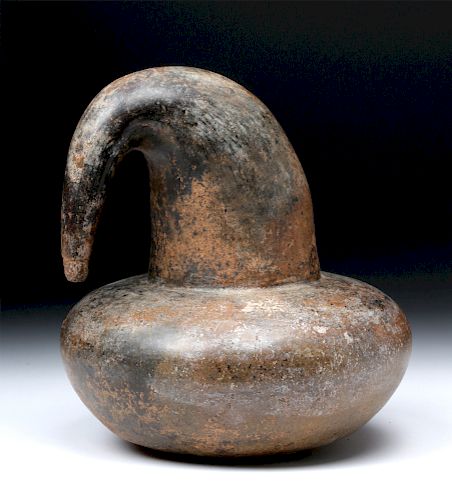Colombian Calima Pottery Squash Vessel
Lot 76a
About Seller
Artemis Gallery
686 S Taylor Ave, Ste 106
Louisville, CO 80027
United States
Selling antiquities, ancient and ethnographic art online since 1993, Artemis Gallery specializes in Classical Antiquities (Egyptian, Greek, Roman, Near Eastern), Asian, Pre-Columbian, African / Tribal / Oceanographic art. Our extensive inventory includes pottery, stone, metal, wood, glass and textil...Read more
Estimate:
$1,000 - $1,500
Absentee vs Live bid
Two ways to bid:
- Leave a max absentee bid and the platform will bid on your behalf up to your maximum bid during the live auction.
- Bid live during the auction and your bids will be submitted real-time to the auctioneer.
Bid Increments
| Price | Bid Increment |
|---|---|
| $0 | $25 |
| $300 | $50 |
| $1,000 | $100 |
| $2,000 | $250 |
| $5,000 | $500 |
| $10,000 | $1,000 |
| $20,000 | $2,500 |
| $50,000 | $5,000 |
| $100,000 | $10,000 |
| $200,000 | $20,000 |
About Auction
By Artemis Gallery
Jan 24, 2019
Set Reminder
2019-01-24 10:00:00
2019-01-24 10:00:00
America/New_York
Bidsquare
Bidsquare : Pre-Columbian / Ethnographic Art
https://www.bidsquare.com/auctions/artemis-gallery/pre-columbian-ethnographic-art-3814
Featuring ancient and ethnographic art from around the world, including Pre-Columbian, Native American, African / Tribal, Ethnographic, Spanish Colonial, Fossils, Fine Art, much more. Artemis Gallery info@artemisgallery.com
Featuring ancient and ethnographic art from around the world, including Pre-Columbian, Native American, African / Tribal, Ethnographic, Spanish Colonial, Fossils, Fine Art, much more. Artemis Gallery info@artemisgallery.com
- Lot Description
Pre-Columbian, Colombia, Calima zone, ca. 1000 BCE to 700 CE. A hand-built terracotta vessel modeled to represent a large gourd with smooth 'skin' - its body of a bulbous form with a long, curled stem. The Calima people lived in the southwestern highlands by the Caribbean coast, and are famous for their goldwork, but they also produced charming pottery works like this example. Size: 7.5" W x 8" H (19 cm x 20.3 cm)
The gourd form has a special history in the Calima region of Colombia. Beneath the volcanic soil of this coffee growing and cattle rearing land of Colombia's Western Cordillera is a rich archaeological landscape; this is because about a century after the Spaniards' landing, the indigenous population diminished, allowing the natural forest to cover the abandoned settlements. New settlers did not arrive in this region until the early 20th century. They promptly began to search tombs for gold which was usually brought to the National Bank of Colombia to be melted down for bullion. However, in 1939, a striking piece of gold shaped like a gourd was brought to the Bank. Struck by its beauty, the officials decided not to melt it down; this inspired a new approach to preserve and protect precious objects and preserve them in the Museo del Oro (Gold Museum).
Provenance: private Omer Claiborne collection, Santa Fe, New Mexico, USA; acquired over the last 40 years
All items legal to buy/sell under U.S. Statute covering cultural patrimony Code 2600, CHAPTER 14, and are guaranteed to be as described or your money back.
A Certificate of Authenticity will accompany all winning bids.
We ship worldwide and handle all shipping in-house for your convenience.
#129256Firing hole at the crest of the curled stem. Normal surface wear commensurate with age. Covered with manganese deposits. Nice burnishing marks.Condition
- Shipping Info
-
All shipping is handled in-house for your convenience. Your invoice from Artemis Gallery will include shipping calculation instructions. If in doubt, please inquire BEFORE bidding for estimated shipping costs for individual items.
-
- Buyer's Premium



 EUR
EUR CAD
CAD AUD
AUD GBP
GBP MXN
MXN HKD
HKD CNY
CNY MYR
MYR SEK
SEK SGD
SGD CHF
CHF THB
THB

















